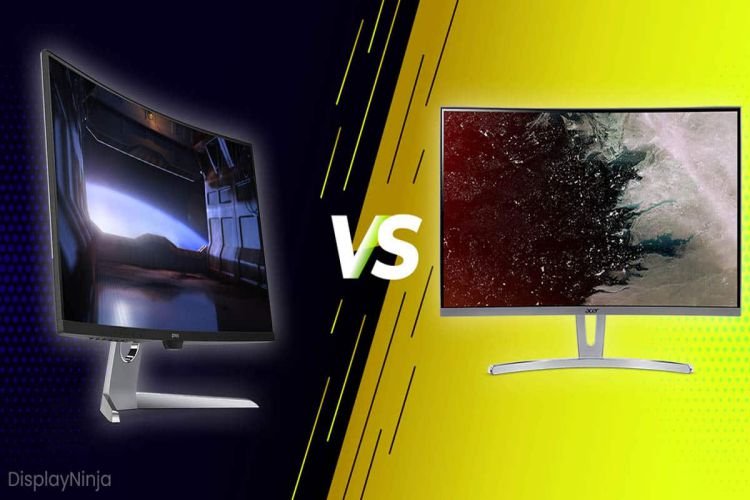 Anyone who needs to work in front of the computer must consider the type of monitor carefully. Even the slightest eye strain and back pains can be remedied just by picking the ideal monitor type for you. If your choice is down to whether to buy a flat-screen vs curved screen, this quick comparison should help you make an informed decision.
Anyone who needs to work in front of the computer must consider the type of monitor carefully. Even the slightest eye strain and back pains can be remedied just by picking the ideal monitor type for you. If your choice is down to whether to buy a flat-screen vs curved screen, this quick comparison should help you make an informed decision.
Curved Screens Win in Reducing Eye Strain and Increasing Comfort
Curved monitors are good for your health because of several things:
- Our eyes are naturally curved, so we do not put much effort into looking at the curved screen.
- The world isn’t flat as well, which means anything you see on a curved screen will look more natural to you.
- The wider field of view you can experience from curved monitors reduces the movement of your neck as you work, which means you’ll suffer from fewer stiff necks or back pains.
- A curved screen offers less distortion, mainly because the information displayed from the center to the edges can be seen even if you’re seated in the middle. Meanwhile, flat screens make it harder for your eyes because we have to refocus our vision every time the scene goes to the edge then back to the center.
Generally, curved displays offer a different level of ergonomics not found on flat screens. The wider your screen, the more comfortable it would be for your eyes.
Flat-screen monitors win price-wise
FIltering your choices from several down to a suitable monitor for your needs can be a HUGE help especially in a market with hundreds of options. Flat-screen monitors have been around longer, which means people know what they could do and how appropriate they are for specific jobs.
Although Samsung was the first in launching curved monitors in the market, other brands have now introduced their own curved versions as well. What used to be a pretty expensive option, curved screens nowadays are more affordable and with more brands expected to release more models featuring this technology, the only way for the price tag of curved monitors is to go down.
Curved Screens win the Multi-tasker’s heart
The cool thing about curved screens is that they are often available in bigger sizes (this is because you have to really go big for the advantages of curved displays to be felt). As such, anyone using the monitor would immediately receive a wider field of view and a bigger real estate to work on.
Yes, this is also possible with a flat-screen monitor, but you’d have to buy either a larger-sized display or set up two or more screens for your office to reach the immersive experience you can get with just a single curved but massive monitor.
With plenty of space, you can open several applications simultaneously at any given time, which makes multitasking possible and hassle-free without the need for minimizing or switching between displays.
Same specs, but flat-screen monitors win with a more affordable price
If you really want to weigh the differences between a flat monitor and a curved monitor, you’ll likely get confused because many of the important monitor considerations such as refresh rate, response times, HDR, color accuracy, and even resolutions are very similar in flat screens and curved screens.
You can also find the same panel type (IPS, VA, and so on) from either the flat-screen or curved screen market. If your issue is the technology for gaming (NVIDIA G-Sync or AMD FReeSync), you’ll soon realize that both of these monitor types offer the tech you’re looking for. You’re not really missing out if you go with a flat-screen OR curved screen.
However, if your main consideration is the aspect ratio, this is where the battle begins. A curved monitor has a 21:9 screen ratio, which is over 2 times wider than flat-screen displays. This means any size of monitor you pick, the curved monitor will be about 2 times greater in width than the flat-screen monitor.
Note that the curved monitor’s screen ratio can be a deal-breaker if you wish to connect this to your game console since popular consoles only support 21:9 for now, so you’d have to stick with flat screens.
Lastly, if you cannot afford the price of curved monitors just yet, then there would lie your problem. Flat screens are definitely more accessible to people and more brands have them in different sizes as well.
It’s a tie!
No, curved screens aren’t just for gamers and movie-watching peeps. The extra-wide display that offers expansive real estate is also appropriate for a wide range of business users.
However, flat screens are definitely cheaper, more popular, and offer more setups to a wide range of people.
Deciding which one is best for YOUR workstation should be able to dictate the answer to your flat screen vs. curved screen dilemma.




